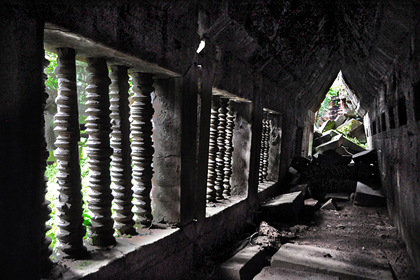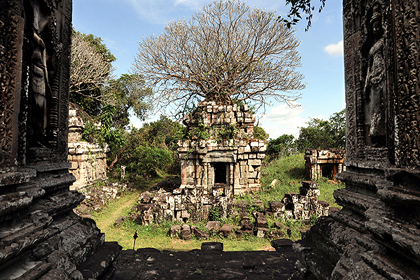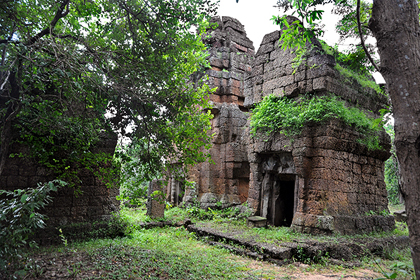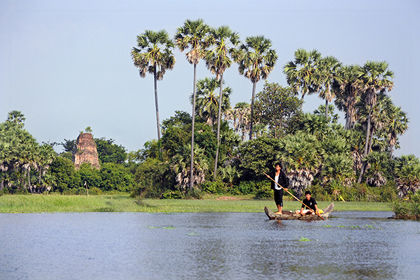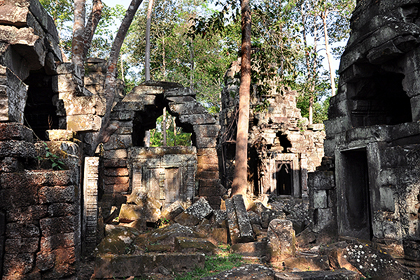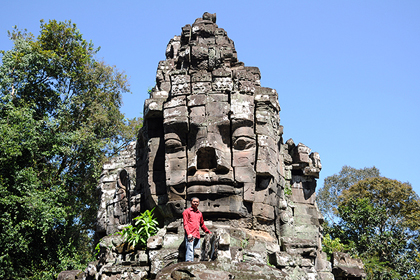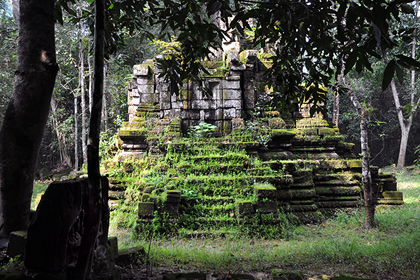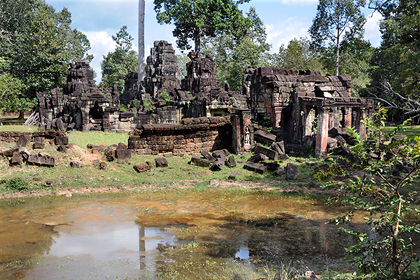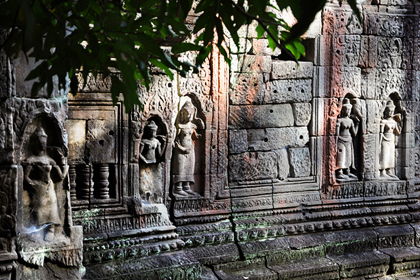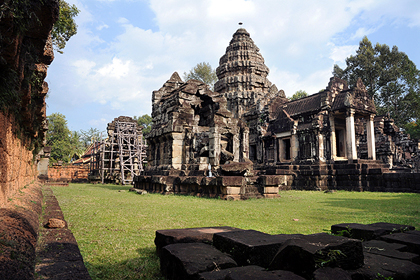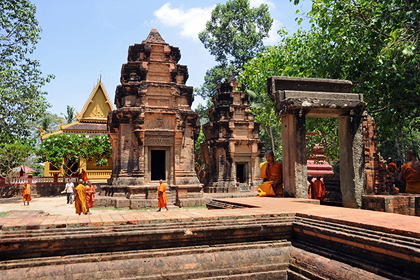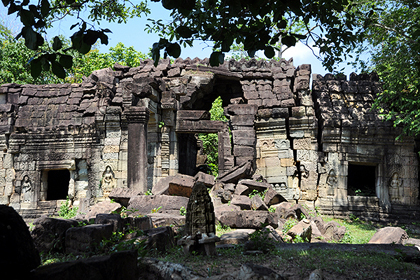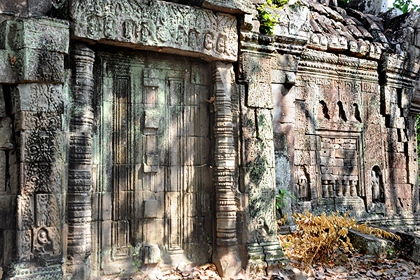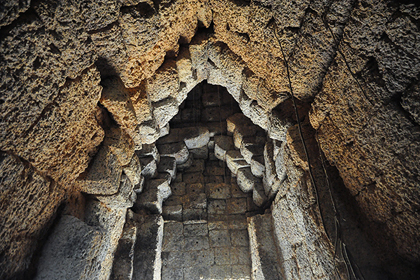Insider specials: Angkor's forgotten temples in the jungle
|
Angkor is the largest historical temple town at all and Angkor Wat the biggest single ancient temple in the entire world. This webpage is focussed on those temples in Angkor and its vicinity that are off the beaten track and less well known. If you are interested in information about the more famous and most visited Angkor temples, too, please visit my separate website www.angkor-temples.com.
Angkor will have 3 million visitors annually. Don't expect lost temples in the jungle any more when visiting the famous temples at Angkor's two circuit roads, like most tourists and groups do. But, yes, there are still many remote and forgotten temples that will meet your explorer adventure expectations. Most of them are single or triple towers in ruins, for example Kutishvara near jungle temple Ta Prohm. Only small foundations remain of Kapilapura near Angkor Wat. Far away temples are still too dangerous because of landmine risks, for example Prasat Char. However, there are one or two dozen temple complexes in and around Angkor which are safe and silent and not at all too small. This webpage introduces the largest and most interesting of Angkor's forgotten temples, those that are really worth visiting and can be called "special insider tips". |
If you like to visit the famous as well as the forgotten temples in Angkor, please fill free to contact me. I am an experienced driver for real explorers and enthusiasts.
email address: [email protected], phone number is: (+855) 069 51 01 41 |
East of Angkor specials: on the way to Beng Mealea and Koh Ker
|
Chai Say Vibol is Angkor's vastest temple complex outside the touristic zone, it was located on the route from Angkor to the northeast, halfway to Beng Melea and the sandstone quarries of Phnom Kulen. Visitors should neither expect intact buildings nor delicious works of art, Chau Say Vibol is unrestored. Even the original structure was not luxurously decorated, though it was constructed in Angkor's heydays in the 12th century, most probably in the Angkor Wat period in the first half of the century. Inside this huge compound are two completely different structures worth a visit, one is on the top of the natural hillock in the very centre, the other one is at its southern basis. Both are in ruins, but well recognizable.The function of the latter one is unknown. It is a kind of cloisture, a courtyard surrounded by galleries, with a Gopuram to the west. more...
|
|
Phnom Bok is the most exciting untouristed place in the Angkor area, but visiting Phnom Bok requires climbing 600 steps to the top of the 235 m high hill. Phnom Bok is one of the first temples in Angkor. It was erected by King Yashovarman I (889-910), who is the founder of Angkor as Khmer capital. He built three temples on top of all three hills in the plains of Angkor. Phnom Bok has three Prasat towers, one for Brahma, one for Shiva, one for Vishnu, and four more edifices in front of them, only the two inner ones made of sandstone are still complete, but surmounted by Frangipani. One of the hugest Lingas ever built in Cambodia is broken, because it fell down, when art thefts tried to remove it. The broken pieces can be seen under a new shelter 300 m behind the main temple complex. All in all, Phnom Bok is similar to the contemporary Phnom Krom at the Great Lake. more...
|
|
Prasat Tor is a smaller structure east of Angkor, located close to the north-east corner of the East Baray. The track to Prasat Tor crosses a typical Cambodian village situated on the crown of the dam of Angkor's former reservoir East Baray, which is dry now. The temple consists of two laterite towers, orientated east. A Mandapa hall precedes the southern tower, but seperated instead of being connected to the main sanctuary by an Antarala. The Prasat has a sandstone lintel depicting a god enthroned on Kala demon. Parts of Prasat Tor may be more ancient, but the temple is attributed to the Buddhist King Jayavarman VII (Bayon period). Remarkably, Prasat Tor was dedicated to Shiva. Most of the many, many temples erected by Jayavarman VII were Buddhist, of course. But the smaller Shiva temple Prasat Tor in the outskirts of Angkor prooves that the king was tolerant. more...
|
|
Trapeang Phong is situated 3 km south of the Bakong temple pyramid in Roluos. There are not many tourists or even tour guides who have ever seen Trapeang Phong. During and after rainy season, the temple will be on an island in the marshes of the Tonle Sap. But you can ask local farmers for a boat trip. It's recommendable, a dream coming true for those who want to discover the unknown. Only a single Prasat tower made of brick is what remains of this secluded temple. However, it is surprisingly tall. The false doors (or blind doors) are of sandstone, they are in a good condition. Their lintels and colonnettes are well executed. Most noteworthy are the Devatas (Apsaras) at the outer walls of Trapeang Phong, since these depictions of Angkor's famous female semi-deities are the oldest in Khmer art at all. Some of them are under restauration. more...
|
Small Circuit insider tips: forgotten temples right in the heart of Angkor
|
Ta Nei is a smaller brother of the famous jungle temple Ta Prohm, about one kilometre deeper in the jungle to the north, reachable only via forest track not passable for cars. In Ta Nei you can listen to the sounds of animals instead of hearing clicking cameras or noisy groups of amused travellers. Many of the structures in the temple court have collapsed, and it is difficult to walk around over stones and boulders. Like Ta Prohm, Ta Nei was built by the Buddhist ruler King Jayavarman VII in the late 12th century. The main temple complex is 55 m long and 47 m wide. Two Prasat towers in the main axis dominate the temple court. Apsaras and lintel carvings in a pretty sound condition can be discovered at Ta Nei. Some of Ta Nei's stone carvings depict unusual topics. On the north pediment of the Prasat there is a person on a boat giving a blessing, flying figures carry parasols. more...
|
|
Angkor Thom has two eastern gates, the East Gate in the narrow sense at the cardinal point and one more, 500 m further north. The latter is the Victory Gate. The cardinal East Gate is sometimes called "Death Gate", maybe because of its solitude or as it is not the starting point of a major route any more. There is no paved road to the East Gate, only a straight and wide track through the jungle starting at the Bayon temple in 1.5 km distance. This is why the East Gate sees not many visitors and is a completely silent and restful impressive monument located right in the middle of the tourist hub Angkor. Thus, the East Gate offers best chances to experience the magic of Angkor off the beaten track. All five city gates of Angkor Thom are similar in size and design. The 23 m high Gopurams have three aligned towers, the central main tower with two opposing faces to the fronts. more...
|
|
The path leading to Mangalartha begins 400 m in front of the Victory Gate. In the rainy season or after heavy rainfall the track will not be passable without boots. Mangalartha is the last stone building and the last Hindu temple erected in Angkor and also the last monuments with a dated inscription. "Mangalartha" is derived from "Jaya-mangalartha", the name of an influential priest living in the thirteenth century. He was the founder of the temple or was posthumously honoured by its consecration. Jayamangalartha was the son of a foreign Brahmin who was a Guru and court priest of the Buddhist King Jayavarman VII. This is one more example for his tolerance and the importance of Hindu priests at Buddhist courts in Southeast Asia. Already commissioned by Jayavarman VII in the early 13th century, this private temple was not consecrated until 1295, on 28th of April. more...
|
Grand Circuit insider tips: forgotten temples from the Bayon period
|
Banteay Prei means "citadel of the jungle", though Banteay Prei is not really a jungle any more, but at the border of the forested Angkor Park to the surrounding farmland. Sometimes the meadow of the temple is used as pastureland for cattle. Banteay Prei is a medium-sized compound. Banteay Prei is one of the many edifices founded by the record-breaking temple-builder Jayavarman VII, about 1200. In layout and style, it is similar to Ta Som and Ta Nei, two more famous temples originating from the same Bayon period. But galleries, Gopurams and the central Prasat tower are less high at Banteay Prei, that's why it almost appears to be a temple en miniature. Inside the exterior (counted "third") enclosure there is a moat surrounding the core compound, 80 m by 60 m. The galleries forming the inner enclosure are 30 m from east to west and 25 m from north to south. more...
|
|
Krol Ko is a small temple compound next to the Neak Pean car park at the Grand Tour road. The main entrance is from the east through a simple opening. A moat lined with steps surrounds the inner enclosure. The main court is defined by this 25 by 35 metres inner laterite wall. Its entrance is a Gopuram, now without roof. On the left side there is a so-called library building. The principal temple is a Prasat with an eastern Mandapa-Hall. The ornamentation is in the Bayon style, some Devata sculptures in niches are well-preserved. Main attraction of Krol Ko are some bas reliefs of former pediments, they are reconstructed on the ground. Some of them represent the Bodhisattva Lokesvhara, to whom the temple may have been dedicated. He is depicted on a lotus. Lokeshvara "World's Lord" is the most popular Southeast Asian variant of the Mahayana Buddhist saviour Avalokiteshvara. more...
|
Siem Reap insider tips: the rarely visited ancient temples in town
|
Prasat Wat Athvea, not a small ancient temple compound, is situated in the southern outskirts of Siem Reap, only 200 metres to the right of the road leading to Chong Kneas and the Tonle Sap. The ancient monument is now part of a pagoda of the same name ("Wat" means "monastery"). The complex supposedly originates from the same time as the Angkor Wat. As there are no details concerning the foundation date mentioned in inscriptions, only stylistic details indicate the time of origin. Contrasting to other temples from the same Angkor Wat style period, Wat Athvea almost completely lacks sculptural ornamentation, maybe it was never completed. Wat Athvea's only Apsara sculptures are found on decorated pilasters at the doors leading from the Mandapa hall to the cella, which is inside the main Prasat. The Apsara sculptures are in the classical style of Angkor Wat. more...
|
|
The small monument is located in the northern part of Siem Reap city, at the Siem Reap river. The ancient structure is surrounded by modern buildings of the pagoda called Wat An Kao Sai. There are foundations of an ancient enclosure and two fire shrines and upright standing stone doors of a former East Gopuram. The temple proper consisted of three aligned Khmer Prasats. One is not existing any more, there is now a modern stupa (dagoba) on its base. The two remaining other towers are restored. They are of different size, one with a five-level roof, the other one only with four. The inscription at the door jambs of the taller tower is dated 968. The pediment reliefs above the Prasat doors are excellent. They could be the oldest representation of such well-known subjects as Krishna lifting Mount Govardhana and the Churning of the Milk Ocean that became very common in Khmer art. more...
|
West of Angkor specials: the remote lost temples, unknown to tourists
|
Due to its secluded location to the north-west of Angkor, the medium-sized Banteay Thom is still a hidden temple completely free of tourist. It can only be reached by motorbike or mountainbike. It is not easy to find. Banteay Thom is overgrown by thicket and grass. One impressive building-strangling tree, already rotten, finally fell down from the gallery's roof into the main temple court in March or April 2013. Only its roots covering the the south-east corner of the temple proper still remain. Nevertheless, you will hardly find another temple in Angkor as tranquil and breathtaking at the same time as Banteay Thom. It's the real big stuff for those seeking to experience the "forgotten temple in the jungle" or simply the perfect setting for contemplation. Banteay Thom was erected under the famous first Buddhist ruler in Angkor, Jayavarman VII (1181- ca.1218). more...
|
|
Prasat Prey Prasat, because of its name, could be easily confused with Prasat Prei near Preah Khan. But the Prasat meant in this article is far away from the Angkor roads, a few kilometres to the north-west of Angkor Thom. It sees only very few visitors and can not be reached in the rainy season or after heavy rainfall. The temple consists of a single Prasat tower with a preceding Mandapa hall to the east, plus a separate structure that could have been a Vahnigriha (fire shrine). The ensemble is enclosed by a laterite wall with gates to east and west and surrounded by a series of water basins, each of them bordered by laterite steps. The pediment relief at the east entrance of the Mandapa vestibule depicts the Bodhisattva Lokeshvara standing between Vishnu and Brahma. The Buddhist sculpture is defaced, most probably during the reign of Jayavarman VIII who reestablished Hinduism. more...
|
|
The elongated shape of Prasat Sampeau's antechamber hall in front of the tower resembles that of a ship, that’s why the structure got its modern Khmer name meaning "sanctuary ship". Located 10 km north-east of Angkor Thom, this is one of the most remote and unknown temples in Angkor. Prasat Sampeau was one of 121 so-called "Vahnigrihas" King Jayavarman VII claims to have built, according to a famous inscription at Preah Khan. These "fire-houses" were erected along the major routes from Angkor to other cities. Prasat Sampeau is the Vahnigriha closest to his capital Angkor Thom, the only one in Angkor's present-day archaelogical zone. Most of the Vahnigrihas marked the route from Angkor (called "Yashodharapura" in that inscription) to the north-east, namely to the neighbouring Champa empire in what is today central Vietnam. more...
|
Travel to hidden temples in Angkor
My main business are day trips in Angkor. I offer van tours, but I am a tuktuk driver as well. So you have a choice: more comfortabe tours in an A/C vehicle or local style budget tours. Almost every morning I am available in Siem Reap's popular guesthouse area between Bun Seda Angkor Villa and Garden Village. This is only half a kilometre to the west of the Old Market and Pub Street in Siem Reap's town centre.
I am an experienced driver and have also some regular guests who have special wishes to see remote temples, too. I know many more places than only those monuments along the normal tourist routes. So I can help you to find the places described on this page or on my other websites. Indeed, I hope these offers to see the extraordinary untouched temples will attract more customers. You should be aware that some of these special places in Angkor are not as easy to reach as the more famous temples at the ring roads. For example, you would have to climb 600 steps to visit Phnom Bok, which is one of the most amazing unknown temples. Another highlight for lovers of hidden temples is Banteay Thom. It can only be reached by motorbike. So couples will need to drivers, or we stop at the main road and have to walk the last three kilometres. Some temples such as Prasat Prey (near Banteay Thom) cannot be reached after heavy rainfall. For visits of Trapeang Phong you will have to pay additionally for hiring a private boat, though it's really not too much, because farmers in such remote areas are usually not involved in the tourism business. |
|
contact
driver from Siem Reap to Koh Ker temples:
Pheak (Hor Sopheak), Number 648, Group 8 Vihear Chen Village, Siem Reap, Cambodia; phone: (+855) 069 51 01 41
[email protected]
___________
copyright 2014 photos and texts:
Ando Sundermann, Grünental 6, 32760 Detmold, Germany, (+94) 052319438185,
[email protected]
All rights reserved.
driver from Siem Reap to Koh Ker temples:
Pheak (Hor Sopheak), Number 648, Group 8 Vihear Chen Village, Siem Reap, Cambodia; phone: (+855) 069 51 01 41
[email protected]
___________
copyright 2014 photos and texts:
Ando Sundermann, Grünental 6, 32760 Detmold, Germany, (+94) 052319438185,
[email protected]
All rights reserved.
